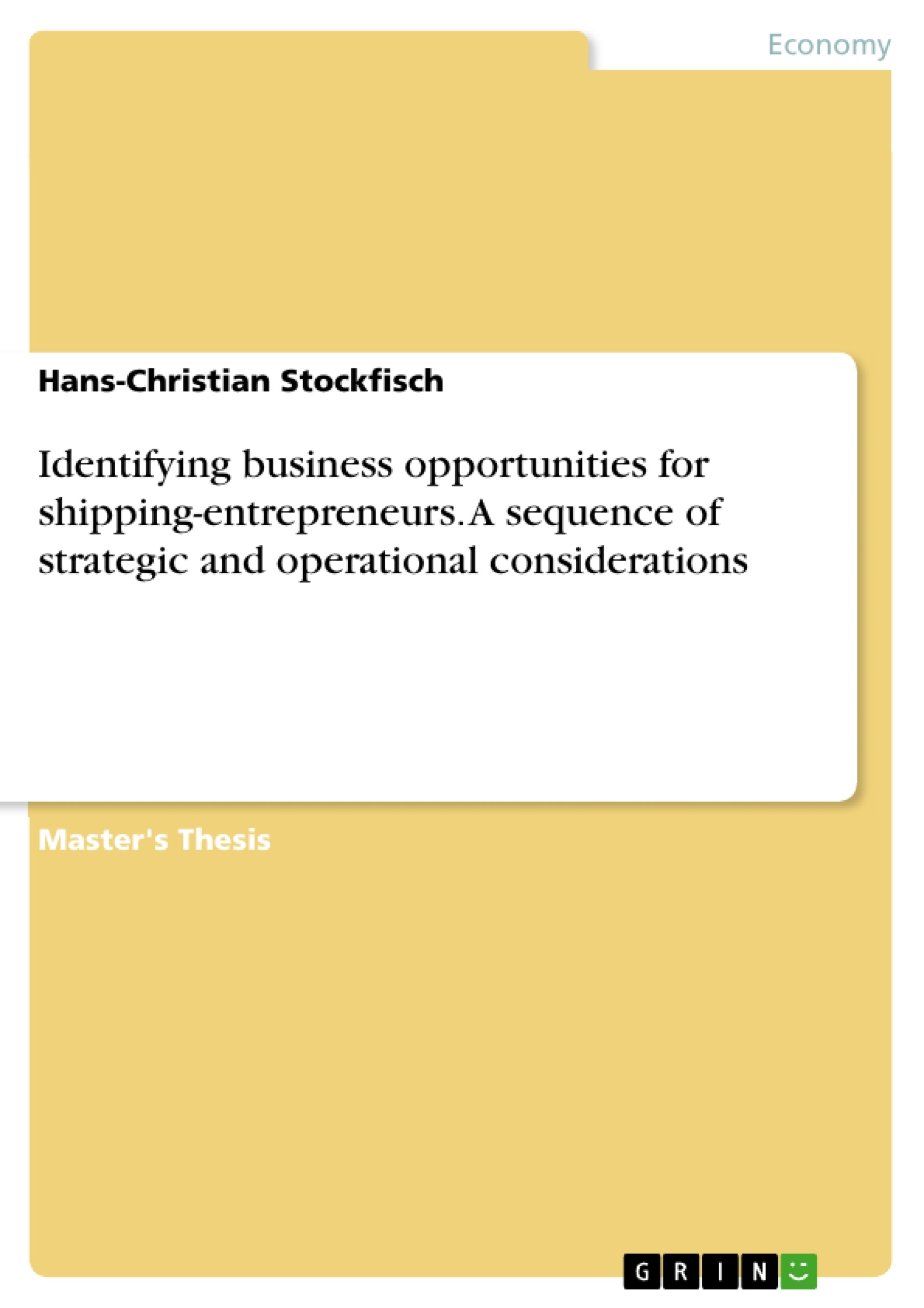This thesis develops a methodology that gives guidance through the process of identifying a business opportunity in shipping by spotting an emerging niche in the market and setting up a corresponding business model to establish a promising company. The focus lies on shipping entrepreneurs, who are entirely dependent on investment capital and therefore
have to be well prepared to attract investors. The thesis is composed of five chapters. Chapter One is introductory, defines the basic terminology and sets assumptions for the further analysis. Chapter Two explores the signals, indicating emerging niches in the market, covering the first part of identifying a business opportunity. Chapter Three and Four cover the second part of the identification process, discussing considerations regarding the strategic framework as well as the operational management of the startup. Conclusions are drawn in chapter Five. The key findings are that the financial and corporate structure of the business model is mutually dependent. Therefore a holistic approach of the venture must be taken into account to successfully identify and approach a business opportunity. Furthermore it is found that the entrepreneurs have to integrate a prudent risk management to attract investors and to prepare the company for present and future challenges. This should be complemented by a proactive and transparent style of management. However, there is no unique all-in-one solution for the establishment of a new company as every business case is different and must be conducted individually. Nevertheless the tools and considerations presented in this thesis offer practical guidance and lower risks and uncertainties in the decision-making processes of the shipping-entrepreneurs.
Table of Contents
- Introduction
- Methodology
- Shipping-Entrepreneurs
- Business Opportunities
- Signals for Business Opportunities
- Macroeconomic Signals
- Demand & Supply
- Shipping Cycle
- Forecasting and Market Research
- Microeconomic Signals
- Emerging Maritime Clusters
- Professional Networking
- Competitive Analysis
- Key-Trends
- Technology Improvements
- Electronic-Services and Automation
- Regulatory Framework
- Business Set-up Considerations
- Financing the Business
- Traditional Financing Systems in Shipping
- Finance Opportunities for Shipping-Entrepreneurs
- Attracting Investors
- Business Model
- Strategic Framework
- Management Team
- Environment and Localization
- Exit Strategies
- Management Considerations
- HR-Management
- Cost-Control
- Risk Management
- Future-Orientation
Objectives and Key Themes
This thesis focuses on developing a methodology that provides guidance for shipping entrepreneurs in identifying profitable business opportunities. The methodology focuses on spotting emerging niches in the market and establishing a corresponding business model to create a successful company. The research acknowledges the unique challenges faced by shipping entrepreneurs, especially their dependence on investment capital. This underscores the need for a well-structured approach to attract investors and build a sustainable business.
- Identifying business opportunities in the shipping industry
- Developing a comprehensive methodology for identifying emerging niches
- Creating a sustainable business model tailored to the shipping sector
- Attracting investors and securing financial resources for new ventures
- Navigating the complex factors that influence the success of shipping businesses
Chapter Summaries
- Introduction: This chapter introduces the thesis's focus on identifying business opportunities in shipping. It defines key terminology and establishes assumptions for the subsequent analysis.
- Signals for Business Opportunities: This chapter explores signals indicating emerging niches in the market. It covers both macroeconomic and microeconomic signals, providing insights into market dynamics and identifying potential opportunities. This includes analysis of demand and supply trends, the shipping cycle, forecasting methods, emerging maritime clusters, professional networking, and competitive analysis.
- Business Set-up Considerations: This chapter delves into the strategic and operational considerations for establishing a shipping business. It examines various financing options, including traditional financing systems and opportunities specific to shipping entrepreneurs. The chapter also explores strategies for attracting investors, and it analyzes key aspects of building a business model, including the strategic framework, management team, location, and exit strategies.
- Management Considerations: This chapter examines the crucial management elements for a successful shipping venture. It focuses on human resource management, cost control, risk management, and future-oriented approaches to ensure sustainable growth and adaptability in the dynamic maritime industry.
Keywords
This thesis centers on the identification of business opportunities for shipping entrepreneurs, encompassing key concepts like market niche identification, business model development, investor attraction, financial considerations, strategic frameworks, operational management, and risk management. The study emphasizes the importance of a holistic approach to establish successful shipping ventures, addressing both strategic and operational aspects. Key terms include emerging niches, financial viability, market analysis, operational efficiency, and investor relations.
- Citation du texte
- Hans-Christian Stockfisch (Auteur), 2015, Identifying business opportunities for shipping-entrepreneurs. A sequence of strategic and operational considerations, Munich, GRIN Verlag, https://www.grin.com/document/307743



